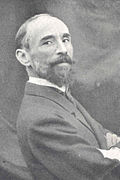File:Turkeys guardian (1871) - Francesco Paolo Michetti.png
Turkeys_guardian_(1871)_-_Francesco_Paolo_Michetti.png (714 × 456 pixels, file size: 787 KB, MIME type: image/png)
Captions
Captions
Summary
[edit]| Francesco Paolo Michetti: Turkeys herder
|
||||||||||||||||||||||||||||
|---|---|---|---|---|---|---|---|---|---|---|---|---|---|---|---|---|---|---|---|---|---|---|---|---|---|---|---|---|
| Artist |
artist QS:P170,Q3081044 |
|||||||||||||||||||||||||||
| Title |
Italian: Guardiana di tacchini Turkeys herder title QS:P1476,it:"Guardiana di tacchini"
label QS:Lit,"Guardiana di tacchini"
label QS:Len,"Turkeys herder" |
|||||||||||||||||||||||||||
| Object type |
painting object_type QS:P31,Q3305213 |
|||||||||||||||||||||||||||
| Description |
Turkeys herder (1871), by Francesco Paolo Michetti |
|||||||||||||||||||||||||||
| Date |
1871 date QS:P571,+1871-00-00T00:00:00Z/9 |
|||||||||||||||||||||||||||
| Medium |
oil on canvas medium QS:P186,Q296955;P186,Q12321255,P518,Q861259 |
|||||||||||||||||||||||||||
| Dimensions |
height: 54 cm (21.2 in); width: 79.5 cm (31.2 in) dimensions QS:P2048,54U174728 dimensions QS:P2049,79.5U174728 |
|||||||||||||||||||||||||||
| Collection |
Private collection institution QS:P195,Q768717 |
|||||||||||||||||||||||||||
| Notes |
|
|||||||||||||||||||||||||||
| Source/Photographer | https://www.pandolfini.it/it/asta-0002-2/francesco-paolo-michetti.asp | |||||||||||||||||||||||||||
Licensing
[edit]|
This is a faithful photographic reproduction of a two-dimensional, public domain work of art. The work of art itself is in the public domain for the following reason:
The official position taken by the Wikimedia Foundation is that "faithful reproductions of two-dimensional public domain works of art are public domain".
This photographic reproduction is therefore also considered to be in the public domain in the United States. In other jurisdictions, re-use of this content may be restricted; see Reuse of PD-Art photographs for details. | |||||
File history
Click on a date/time to view the file as it appeared at that time.
| Date/Time | Thumbnail | Dimensions | User | Comment | |
|---|---|---|---|---|---|
| current | 22:17, 3 April 2021 |  | 714 × 456 (787 KB) | Niketto sr. (talk | contribs) | Uploaded a work by Francesco Paolo Michetti from https://www.pandolfini.it/it/asta-0002-2/francesco-paolo-michetti.asp with UploadWizard |
You cannot overwrite this file.
File usage on Commons
The following 5 pages use this file:
File usage on other wikis
The following other wikis use this file:
- Usage on www.wikidata.org


